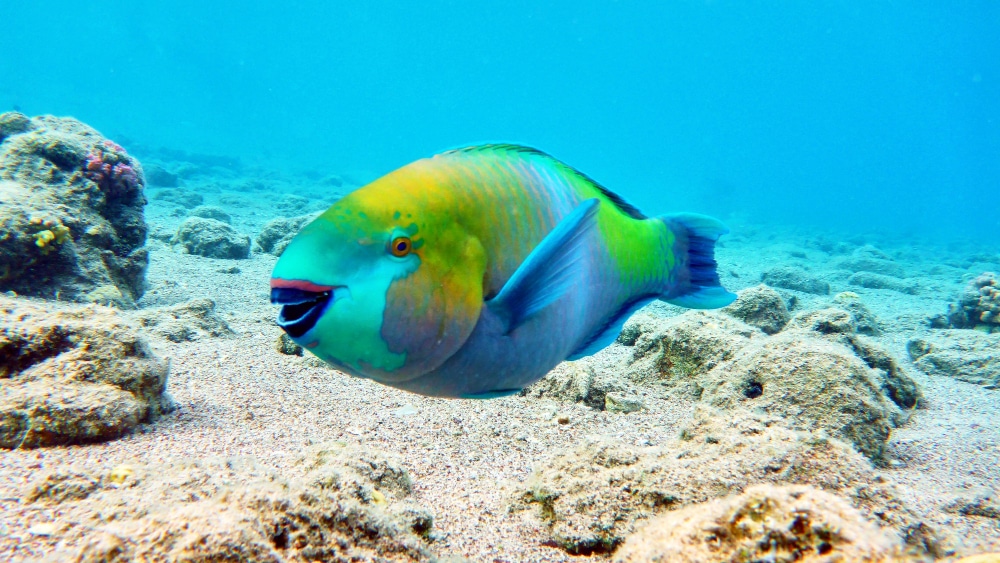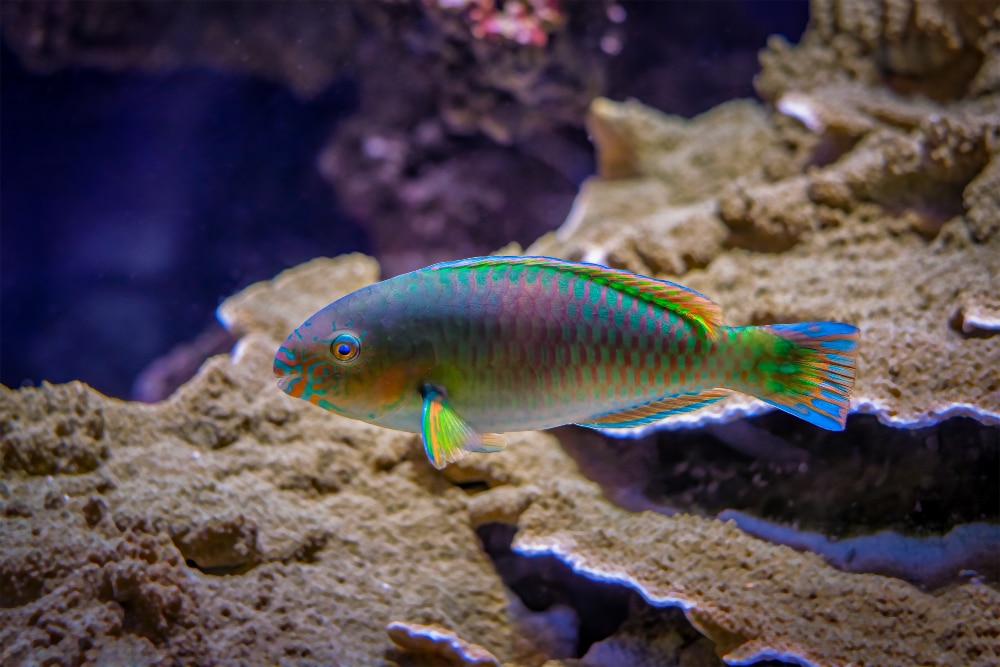Chalice Coral: A Comprehensive Guide for Beginners
Corals are not just beautiful creatures that add color to an underwater world, but they also play a vital role...
Jim Sabellico
March 30, 2022

Our oceans are home to the most magnificent creatures in the world. There is a whole new world blossoming deep in the oceans, breathtaking yet so mysterious. Every fish is special in its own way, but a few stand out from the others owing to some exclusive characteristics. In fact, some species are so out of the ordinary that it’s hard to believe they even exist. One such fish is Parrotfish – a fish with vivid neon colors, intricate patterns, and so many fascinating facts that you would love to know. So, let’s dive in:

The bigger, brighter cousin of Wrasse, Parrotfish, is much more than just aesthetic to look at. It beautifully changes its color, shape, and even gender at certain phases in its life. It’s one of the most important fish that plays a role in coral reef preservation. Around 80 Parrotfish species are known to date, and surprisingly every species is strikingly different from the other. With an average lifespan of 7 years, Parrotfish can reach up to 1.2 meters in length. They have more than 1000 teeth arranged in a mosaic-like form on their jawbones. With such an arrangement, their mouth closely resembles a parrot’s beak, hence rightfully called Parrotfish.
Let’s cut straight to the chase and learn some curiously captivating facts about Parrotfish.
A fascinating fact about Parrotfish is the formation of “Sleeping Bags” exclusive to these fish. Some prominent Parrotfish species surround themselves with a transparent cocoon of mucus before going to sleep at night. They have special glands in their gills that form the mucus capsule. In retrospect, the nightgown protects them from biting bed bugs or parasites that attach to the fish while they sleep. In addition, it also masks their scent that protects them from deadly night-time predators like Sharks, Eels, etc. Also, the sleeping bag gives these fish a heads-up when an enemy tries to attack so that they can escape in the blink of an eye.
Parrotfish teeth are unrivaled when it comes to strength. The fish has 15 rows of more than 1000 teeth that fuse to form the characteristic beak. You might be surprised to know that no biomineral in the world can compete with the stiffness of their teeth. A careful study reveals that a square inch of their teeth can easily tolerate 530 tons of pressure, which equals the weight of 88 elephants (to be exact). In addition, these teeth easily beat metals like gold, silver, copper, etc., in a fracture test. Truly, the fact justifies why corals are their all-time favorite snacks.
We would be remiss if we didn’t chew over their bizarre but incredible feeding habit. With the help of strong teeth, Parrotfish chomp on extremely hard corals. To your surprise, these fish munch at a rate of 20 bites/minute. What goes in the mouth quickly comes out after digestion. The Scuba divers usually spot Parrotfish from the plume of fine sand that they leave behind while swimming. The sand is actually digested coral rock that is of no use for their bodies. On average, a Parrotfish produces around 90 kgs of sand every year. The sand contributes to the formation of reef islands that we often see.
Note: For those who love to bask in the sun, the crystal white sand you see on the tropical beaches is mostly Parrotfish poop.
Interestingly, Parrotfish are highly social, and you may see schools of about 40 members or more. Just like some other fish species, they can swap their gender from female to male as they develop. A big, bright breeding male, “The Supermale,” usually leads a school of smaller and dull females. In addition, the supermale also provides sperm to fertilize the eggs. As time passes and females grow in size, they often change sex and then compete with other males for the Supermale position. Biologists call this process “Protogynous Hermaphroditism.” Every time a fish changes its sex, the changing hormones influence color change. Hence, that justifies the rainbow of uniquely colored Parrotfish you meet in the ocean.
Hundreds of Parrotfish gather to join the special dance on the full moon, followed by a process called “Lek mating.” The males bash their heads together as a power play to defend their territories. Females parade by the aggressive males and turn their faces white as a sign that they are ready for mating. Together, they release eggs and sperm in the water simultaneously, and fertilization occurs. In addition, studies reveal, the males also bash their heads against the domes and coral reefs to mark their territories. Moreover, they are loyal to their breeding place and return time after time to the same place for mating.
A Scuba diver takes delight in diving on the magnificent coral reefs. Aside from the best diving experience, coral reefs offer the most spectacular scenes and spellbinding soundscape. The characteristic sound in the coral reefs is due to the acoustic behavior of Parrotfish. The diver might be able to hear the crunching sound of Parrotfish as they chew on the reefs.
The bite sounds show distinctive repetitive variations in the routine and seasonal feeding patterns. The fused beak, jaws, and strong teeth create the rasping sound effects that you hear. The sounds are further amplified by their swim bladder. These echoes not only shape a coral reef’s soundscape but also help researchers in the acoustic monitoring of the coral reef fish community.
Bolbometopon muricatum, aka Green Humphead Parrotfish, holds the Guinness World Record for the world’s largest herbivorous fish species inhabitant to the coral reefs. This fish species can reach up to 4’11” or 1.5 meters in length. Furthermore, it can weigh up to 75 kgs (165 pounds). Green Humphead Parrotfish are native to the coral reefs in the Pacific and the Indian Ocean. Though the average lifespan of a Parrotfish is around 7 years, Green Humphead Parrotfish can live more than 20 years which is rare for any other species of Parrotfish.
Just like its closest cousin, Wrasse, the Parrotfish has a unique swimming style that varies widely from other species. This fish swims by rowing its body along with its pectoral fins. Hence, every day is an arm day for them. Due to this swimming style, the Parrotfish has highly developed pectoral fins and seamless motion. Thanks to this adaptive swimming style, they are highly agile and jumpy, making them a challenging target for predators and hunters.
And that’s all, folks! Aren’t the interesting facts truly captivating? Above all, Coral reefs grow healthier and faster when Parrotfish are around. If it weren’t for this beautiful fish, our coral reef treasures would soon become suffocated by bacteria and seaweeds. That’s precisely what is happening in the Pacific and the Caribbean Sea, which is alarming. Parrotfish and so many other victims of cruel fishing and hunting are counting on us to protect their homes and the vulnerable ecosystem. So, let’s play our part in eradicating the problem by joining hands with organizations that are working to preserve and restore the Great Barrier Reef and its inhabitant species.
Related article: Are saltwater aquariums hard to maintain?

I am the founder of J. Louis, a digital marketing agency focused on providing innovative solutions and strategies built on a foundation of creative design and technology. A family man who loves travel and reef tanks, I’ve been coined as a jack of all trades, master of a few of them, most specifically website and sales funnel design, monetization and growth strategies, and viral marketing. I began pursuing my passions for business by cutting my neighbor’s lawns when I was just 8 years old and never looked back. Over the past 20 years, I have amassed significant experience providing consulting, design and development services for Fortune 500 companies, government, retail, private individuals, and A-list celebrities.
Corals are not just beautiful creatures that add color to an underwater world, but they also play a vital role...
As we move into the new year, it's time to start thinking about what reef tank LED lighting kits will...

Proceeds from all purchases go directly to Great Barrier Reef Foundation and supporting their mission.
Want to stay connected with all the latest news in the Reef Tank Addict community? Drop your email below!
Proudly Supporting The Great Barrier Reef Foundation
Copyright © 2023. All rights reserved.